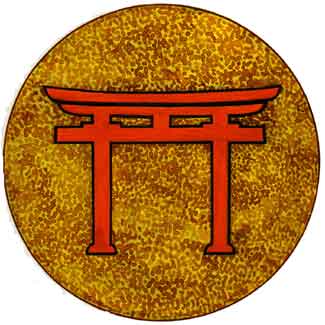This article was posted by CrystalWind.ca.
Shinto Dieties: Kami
- Details

Shinto Dieties: Kami
Kami are the central objects of worship for the Shinto faith. Shinto began as the various ancient animistic traditional spirituality of Japan, and only became an institutionalized spirituality much later as a result of efforts to separate out influences of other religions brought into Japan from abroad. As a result, the nature of what can be called kami is very broad and encompasses many different concepts and phenomena.
Some of the objects or phenomena designated as kami are qualities of growth, fertility, and production; natural phenomena like wind and thunder; natural objects like the sun, mountains, rivers, trees, and rocks; some animals; and ancestral spirits. Included within the designation of ancestral spirits are spirits of the ancestors of the Imperial House of Japan, but also ancestors of noble families as well as the spirits of the ancestors of all people.
There are other spirits designated as kami as well. For example, the guardian spirits of the land, occupations, and skills; spirits of Japanese heroes, men of outstanding deeds or virtues, and those who have contributed to civilization, culture and human welfare; those who have died for the state or the community (See: Yasukuni Shrine); and the pitiable dead. Not only spirits superior to man can be considered kami, but also spirits that are considered pitiable or weak have been considered kami in Shinto.
The concept of kami has been changed and refined since ancient times, although anything that was considered to be kami by ancient people will still be considered kami in "modern" Shinto (modern in that Shinto has been formalized as a unified religion under the influence of foreign religions like Buddhism). Even within modern Shinto, there are no clearly defined criteria for what should or should not be worshipped as kami. The difference between modern Shinto and the ancient animistic religions is mainly a refinement of the kami-concept, rather than a difference in definitions.
In the ancient animistic religions, kami were understood as simply the divine forces of nature. Worshippers in ancient Japan revered creations of nature which exhibited a particular beauty and power such as waterfalls, mountains, boulders, animals, trees, grasses and even rice paddies. They strongly believed the spirits or resident kami deserved respect.
Although the ancient designations are still adhered to, in modern Shinto many priests also consider kami to be anthropomorphic spirits, with nobility and authority. These include such mythological figures as Amaterasu Omikami, the sun goddess of the Shinto pantheon. Although these kami can be considered deities, they are not necessarily considered omnipotent or omniscient, and like the Greek Gods, they had flawed personalities and were quite capable of ignoble acts. In the myths of Amaterasu, for example, she could see the events of the human world. She also had to use divination rituals to see the future.
Traditionally, kami possess two souls, one gentle (nigi-mitama) and the other assertive (ara-mitama). This powerful form of kami was also divided into amatsu-kami ("the heavenly deities") and kunitsu-kami ("the gods of the earthly realm"). A deity would behave differently according to which soul was in control at a given time. In many ways, this was representative of nature's sudden changes and would explain why there were kami for every meteorological event: snowfall, rain, typhoons, floods, lightning and volcanoes.
Amaterasu Omikami 天照大神
Amaterasu is the goddess of the sun and the supreme Shinto deity. Goddess Amaterasu is reverred at the Grand Ise Shrine, which is the only site dedicated to her.
Japanese emperors are said to descend directly from Amaterasu, hence their divine status until Emperor Hirohito was forced to proclaim his human-nature after Japan's defeat in WWII in 1945.
Inari 稲荷
Shinto goddess of rice, sake and fertility, she is associated with foxes ("kitsune") and red torii.
Shrines dedicated to her, by far the most common of all shrines in Japan, are called Inari jinja. The largest Inari shrine in Japan is Kyoto's Fushimi Inari Taisha.
Hachiman 八幡
Shinto god of war, also worshiped by peasants and fishermen as the god of agriculture and fishery. Hachiman is identified with 3rd-4th century Emperor Ojin (応神).
The kanji for Hachiman (八幡) can also be read Yawata meaning "eight banderoles". Hachiman shrines (八幡宮) are quite common in Japan. The largest in Tokyo is Tomioka Hachiamgu and the largest in Kanto is Tsuruoka Hachimangu in Kamakura.
© CrystalWind.ca 2024. All content (articles, imagery, fair use) & design protected. Written permission required for copying. All rights reserved.
Join the Conversation Now! Comment Below! ![]()

Spirit Animal Totem Of The Day!
Crystal Of The Day!
Latest Articles
CrystalWind.ca is free to use because of
donations from people like you.
Donate Now »

Unlock Your Light: Join Lightworkers Worldwide on CrystalWind.ca!
Articles: Shinto
Follow Us!
Who is Online Now
We have 35114 guests and no members online
Featured This Month
Taurus Mythology
The Taurus Myth The Taurus myth is most often interpreted as the story of Z... Read more
Frogs Return Moon
Beaver – Chrysocolla - Blue Camas – Blue April 20 – May 20 The Frogs Retur... Read more
Bright Beltane Blessings!
The wheel turns to Beltane, also known as Mayday, marking the beginning of S... Read more
The Crystal Wind Oracle Card Deck
The Crystal Wind Oracle™ The Crystal Wind Oracle Myth & Magic Card D... Read more
Cartomancy - Fortune Telling Using Playing C…
Cartomancy is the act of divining using cards. Divining means to find out by... Read more
Sun in Taurus
Sun in Taurus April 21 through May 21 An Overview of Sun Sign Characteristi... Read more
The Seven Chakras and their Meanings
If you could imagine chakras as circles of energy, flowing all the way throu... Read more
The Time of No Time: Beltane!
Around the medicine wheel of life we go, from season to season (solstice to ... Read more









































